

|
The Steeplechase A Learning Experience in Key Largo By Mike Hill |
| The Steeplechase is a 110 mile race around Key Largo in the Florida Keys. This was my first experience with distance racing, as well as my first experience at open water navigation. This race has all of the elements that a racer could want. On the first day the race starts in a bay just past a drawbridge. The race then continues out to the Atlantic and down the coast of Key Largo where it ends on a sandy beach on the Atlantic side. The race then starts again the next morning with a LeMans start from the beach and continues up the inland waterway to Rickís Place in the upper end of Key Largo close to where the race originally started. This venue is probably one of the best that I have ever encountered. |
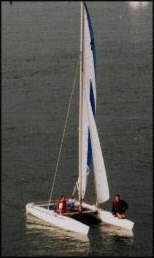
|
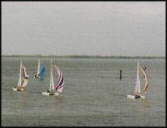
| This race takes a lot of preparation and should only be attempted by sailors with a wealth of experience. The vast majority of the 45 boats entered were 6.0ís with chutes. Many of the boats are entering the Worrel 1000 in a few months. There are no chase boats and no race committee, so you need to be prepared for anything that might happen in the Atlantic Ocean during the race. There is simply a start line and a finish line. May the best man win. The following is a first hand account of my experiences during this race. |
|
On the first day of the Steeplechase the predicted winds were around 15 mph. with some showers possible during the day. We started on a nice sunny morning with the wind blowing 10-12 mph. We had a beautiful downwind start and proceeded to be left by the spinnaker boats on the first 15 miles of downwind |
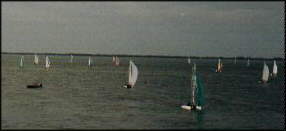
|
|
sailing. We were one of the first stock boats
to reach the bridge. Just prior to running through the bridge we saw a
Hobie 20 make it through and decided to go between the same pylons
that the Hobie 20 went through. When I was getting very close the
people on the bridge were yelling at me to go left. I saw the Hobie 20 go
through so I wasnít worried on the Prindle 19 at all. Unfortunately the
H20 made it through to the left where we tried a little to far right. We hit
the bridge hard. I steered off to the left and we managed to make it the
rest of the way through. This wasnít the smartest thing that Iíve done
lately.
After we got through Angelfish Creek to the Atlantic side, the wind was on our nose. We knew it was going to be a long day beating to windward about 45 miles. We saw the skies darkening and decided that the better wind was out to sea. We were off shore about 8 miles when I asked Rob why the water was changing color up ahead. By this time the wind had picked up to about 18mph and we were cruising. About this time I heard my rudders pop up and decided it would be a good time to tack. We tacked, got the boards and rudders back down, and we were again cruising very fast. We couldnít believe that we hit bottom that far out into the ocean. |
| The wind continued to pick up some. We were on a Port tack when the wind came through with an increase from 25 to about 35 mph. The wind also clocked radically at the same time. When I had saved the boat we were cruising downwind at about 20mph with the storm. I couldnít see a thing at the time and asked Rob which way was our next waypoint. He pulled out the GPS and it read that we were headed in the opposite direction from the waypoint at about 20mph!! We decided to blow everything |
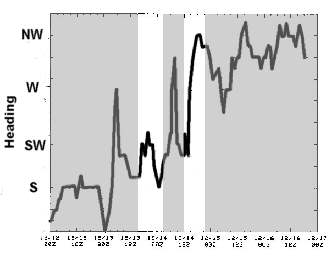 |
|
and crank the boat around to windward again which we
did successfully. We then were beating along in about 35mph of wind. This seemed pretty slow so we pulled out the GPS and confirmed we were only doing about 10mph. Our main was backwinding severely at the top and we couldnít get any shape out of it at all. After going along for about 15 minutes the wind really subsided. We were double trapped about to bring the boat over on us. We couldnít believe it but when the storm cleared we were right in the thick of a pack of boats beating along. Rob went in off trap and we continued beating along very slowly compared to the previous storm. We decided it would be a good time to eat. We broke out the food and soda and I ate and drank right there on trap. This is the first time I have ever been out on trap drinking a soda and steering. We saw another storm approaching and thought it might do us some good since we were again getting hammered by the 6.0ís in the lighter air. The second storm wasnít nearly as impressive as the first. The wind probably didnít surpass 30mph. Once again we were making ground on 6.0ís like crazy. We crossed tacks with Hans Meijer a couple of times and we were feeling pretty good about our position. We kept looking down at the GPS and it was saying about 18 miles to the finish. After the second storm we were mostly single trap to no trap for the rest of the day. It was probably about 6:15 and very dark when we were cruising along near Indian Key and I saw the boards dragging again. We kind of laughed because we saw Steve Vanderbol on a Nacra 6.0 ahead and to leeward of us with his boards down. We knew he was in for an abrupt stop. We tacked got the boards down and continued to watch the 6.0. For a minute I was really disappointed because I though he might have found a hole to get through the mud to leeward of us. We soon saw his crew scramble for the boards and they tacked out of there. This might seem a little mean, but when you are getting hammered by faster boats itís fun to get a chance to pass them. We found the finish line for the first day at about 7:05pm. We were beat but not as bad as I thought we would be. This was my first distance race and the thought that I had traveled 60 miles through some tough conditions while using my new found navigational skills made me feel great. On Sunday morning we arrived early for a 9:00am start. We checked the leader board and found we had finished in 20th out of 45 boats. We felt good about the position and hoped we could improve on it |
|
on Sunday. The wind was predicted to be 20-25 and we thought we
would have plenty of power for some great sailing. We had a Lemans
start and it was a good one. We were doing well but having a terrible
time getting the rudders down. Try steering on a reach with you rudders
up in 20-25. Itís no fun at all. I went back to try to pull the leeward
rudder down when we got hit by a wave. I went off the boat but
managed to hold onto the rudder casting. It drug me for a while but I
couldnít hold on. I was separated from the boat. Rob put the boat into
irons and I tried to swim to the boat. Since I couldnít swim fast enough, so
I motioned to Rob to bring it around to pick me up. He
had a terrible time in the wind coming around but finally managed to
pick me up. I was sure glad he did because, while I was waiting, it
dawned on me that I was being washed out into the Atlantic Ocean and
only he and I knew where I was.
|
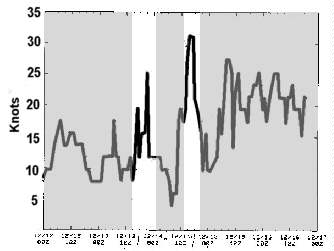 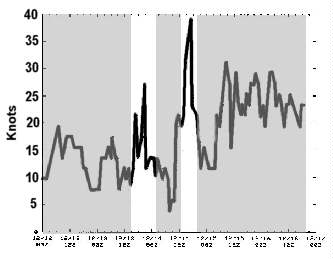 |
|
After I was back on the boat we started to take off again when we saw
another crew separated from his boat. I clocked my stopwatch and
marked the position on the GPS. We tried to turn into irons and wait for
him but we were about 20 feet away. I thought Iíd bring it around for
another try. When I tried to turn downwind the boat immediately tried to
pitchpole. I tried this a couple of more times and we were having real
problems turning the boat downwind. We finally decided we really
needed to pick the guy up out of the water and we did our best to make
the turn. We stuffed twice and on the third stuff we pitchpoled. This the
first time I've ever pitchpoled with both of us on the back crossbar. All
we could do was yell at each other to hold onto the boat. We got up on
the hull and decided that we were finally moving downwind at a good
clip on our side. We started to scan the water for the man overboard
and we couldnít find him anywhere. By this time the man on the boat
was starting to disappear on the horizon. I was getting really worried
because I knew there was no way we could find and help these guys.
We decided to go in and get help.
We drifted downwind far enough to get into shore on one tack. We sailed into shore and beached at a marina restaurant. We ran inside and called 911. The lady at the restaurant was very nice and called her husband who owned a fishing boat at the marina. The Coast Guard called us back and I gave them the location of the man in the water. Me and Rob then went out on the fishing boat The Christy Lynn, with Craig, Alex, and another gentleman whose name I unfortunately forgot. I asked before we left if the boat was big enough for the conditions at hand. Craig, who owned the boat, assured me it wasnít a problem. While going out the conditions seemed to worsen. We were getting tossed all over the place by waves. We were up in the bridge scanning the water for the guy but we couldnít find him anywhere. We decided to go out and check out the Mystere 6.0 to see if the skipper was still on it. As we got further off shore the waves increased. At one point we were in the bridge when the boat started to go over. Me and Rob both got down on our knees and held onto the bars of the bridge in case we rolled. I wanted to make sure I held onto this boat. Intially, Rob and I intended to go out and help the skipper sail the Mystere in. After talking to Rob briefly and looking at the conditions we felt our only option was to offer the man a rescue. When we finally reached the Mystere we asked for his name. We werenít 20 feet from him but we couldnít communicate at all. He initially waved us to go find his crew. Since we already had trouble finding the crew we offered rescue which he reluctantly accepted. We thought about a tow but the captain of the boat was not interested in towing. We didnít argue because I thought the boat would be destroyed by the tow anyway. Besides, our other priority was still to find the missing man. We got the names of the men and called it into the Coast Guard. The man we picked up was the skipper Jack Eure. The missing man was Matt Mayfield. At this point as we were motoring in I was really thinking how close I was on the Prindle 19 to picking Matt up and that I had failed. I was thinking how my poor seamanship had caused a man to be currently lost at sea and probably fighting for his life. I was deeply depressed and mad at myself. I continued to scan the sea behind us but I knew we were well off track from the area that we needed to search, since I felt that he would be well downwind of our position. The visibility was so bad that we were using my handheld GPS around my neck to get back in and find the channel markers. As we approached the first set of channel markers I heard a shout from the bridge. Alex had spotted a man in the water off the Starboard bow! We threw Matt a line and had him in the boat in no time. At this time our radio was out because the water coming into the bridge had fried the radio. We called on Craigís cellular phone and informed his wife to tell the Coast Guard that we had picked up Jack Eure and Matt Mayfield and left the Mystere 6.0 at sea. Matt had been in the water for about 2 Ĺ hours from the time I initially tried to pick him up. He was cold but otherwise in good shape. Matt was very happy to be out of the water and alive. While in the water had grabbed a lobster trap ball to stop him from drifting. It was dragging him under, so he cut it loose. He them used that Styrofoam ball for extra floatation and managed to grab another ball and hook it to his trapeze harness to hold his position. In retrospect if Matt would have had a personal rescue beacon or some hand held flares, we would have been able to find him much quicker. He did have a whistle but it was useless with the wind and wave noise that was deafening out on the boat. Rob and I were sad, having not finished the race. We were also sad at the loss of the Mystere 6.0, but we were elated that we managed to help two fellow sailors. We are very thankful to the folks who helped us find the sailors and wish we could return the favor somehow. There were many sailors that were helped by the kindness of others that day. One man washed up on shore at a hotel. The owner offered him a hot shower and some brandy. Sometime when people are talking about how terrible those motor boaters are, Iíll remember this day for their compassion and kindness they showed to a bunch of sailors in distress. People washed up all over Key Largo on Sunday. Some of the best sailors from all over the East coast were in this race. 45 boats started on the first day and five boats finished the race on Sunday. The highest gust measured by a weather beacon nearby was 47mph. The average wind, as measured by the nearby weather beacon at Molassas Reef, for one hour during the race on Sunday was 40mph. Stuff Iíve learned: Required Equipment to have |
| 1. | Personal Rescue beacon attached to your body. |
| 2. | A good Coast Guard Approved brightly colored life jacket (Red, Orange, or Yellow). I canít stress the brightly colored part enough. I seriously think they should outlaw black, blue, or white lifejackets. |
| 3. | 3 hand held flares on your body. |
| 4. | Drysuit or wetsuit that will keep you warm if you are in the water for more than 24 hours. |
| 5. | Sunscreen (bullfrog) on your body. |
| 6. | Knife that is handy to cut lines free of you. |
| 7. | Handheld Compass on your body. |
| 8. | Water bottle on your body. |
| 9. | Waterproof chart of the area on your body. |
| 10. | 10ft piece of line (3/16 - ľ) on your body. |
| 11. | Anchor and line on the boat. |
| 12. | A throwable with 30 ft of line attached to it and the boat where it is easy to access quickly. |
| 13. | Some type of wetsuit boots to protect your feet. |
|
Nice things to have on your body. |
| 1. | Waterproof VHF radio in waterproof bag. |
| 2. | Waterproof GPS in waterproof bag. |
| 3. | Waterproof personal EPIRB in waterproof bag. |
|
Always use your hiking straps when moving around on your boat.
Always!! Always!! Stay with the boat!! Do not try to make a swim for shore ever!!!! Finding a boat in the ocean is easy compared to finding a person. If itís to windy for the person on the boat to turn it around for a pickup of the other person. Have the person on the boat get windward of the person in the water. Then signal to each other the plan to flip the boat. Then flip the boat directly to windward of the person in the water. The person in the water should swim at a 90 degree angle to the wind to intercept the boat. Itís very important to pick the person up before he gets too far separated from the boat. If the person on the boat looses sight of the person in the water he may never find the person in the water. Mike Hill mhill@inlink.com Back to Features |